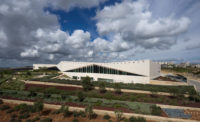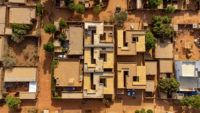Aga Khan Bestows Architecture Awards in Dubai

Leila Araghian (center) received the Aga Khan Award for Architecture from Sheikh Mohammed bin Rashid Al Maktoum, the Vice President and Prime Minister of UAE and Emir of Dubai (left of her), and the Aga Khan (right of her). Marina Tabussum (at the far right), designed the Bait Ur Rouf mosque.
Photo © AKDN/Gary Otte
Anyone who attended the symposium for the Aga Khan Award for Architecture last month couldn’t miss the irony that it was held in Dubai. Amidst the forest of ungainly skyscrapers in that city’s instant downtown (the elegant Burj Khalifa is an exception), architects, jury members, and guests discussed the prize’s six winners—projects of striking modesty, from Beijing to Bangladesh. The 40-year-old award, given every three years, has always stood quietly apart from such venerable prizes as the Pritzker and the Praemium Imperiale— honoring projects, not a singular architect, and acknowledging clients as well as designers. As it has matured, the awards have astutely reflected emerging trends in architectural culture.
This year’s winners, for example, exemplified a strong interest in materials, in micro-urbanism, and in establishing new forms of public space, as jury member Mohsen Mostafavi, dean of Harvard’s Graduate School of Design, put it. While the award has long looked favorably on restoration and adaptive reuse, it has increasingly recognized work with a social impact on underserved communities.
And though the criteria state that projects must be “designed for or used by Muslims, in part or in whole,” the interpretation by the jury seems quite elastic. This year, the humblest winning project was a small children’s library carved out of an old Beijing hutong, designed by Zhang Ke, of ZAO/standardarchitecture (a 2010 RECORD Vanguard winner). The Friendship Centre, an NGO training facility in rural Bangladesh, is a simple but elegant complex of sunken spaces and courtyards, built of handmade bricks, designed by Kashef Mahboob Chowdhury/URBANA. The small Bait Ur Rouf mosque, also in Bangladesh, was designed by Marina Tabussum on the edge of Dhaka. Beautifully built, again in locally made bricks (and radically lacking a dome or minaret), it seems, in its timeless yet modern form, to nod to Louis Kahn.
On a dramatically a larger scale, the Tabiat Pedestrian Bridge in Tehran links two urban parks that were separated by a highway—but it has become an inviting public space in itself, where people gather and linger. Designed by the two young partners of Diba Tensile Architecture, Leila Araghian and Alireza Behzadi, the bridge had 4 million visitors its first year.
While the awards typically shine a light on little-known designers, this year, two famous architects took home a prize ($1 million, divided among all the winners). Bjarke Ingels of BIG led the team that designed Superkilen, a public space in a diverse immigrant community in Copenhagen. The late Zaha Hadid designed the Issam Fares Institute at American University in Beirut and was represented in Dubai by the firm’s principal, Patrik Schumacher. “Each project crosses many boundaries and tells many stories,” said architect Brigitte Shim, a jury member, at the symposium.
The next day, the Aga Khan echoed that idea at the formal ceremony to bestow the awards, held at a 19th-century fort in the city of Al Ain, once an oasis in the desert. “The spirit of pluralism has been central to the best of Islamic culture,” he said, and added: “I am happy to underline that three of the awardees this year are women architects.”



